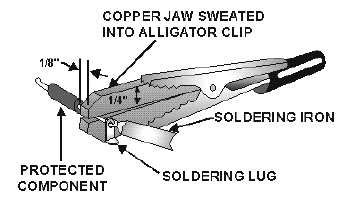2-50
Solder—Ordinary soft solder is a fusible alloy of tin and lead used to join two or more metals at
temperatures below their melting point. The metal solvent action that occurs when copper conductors are
soldered together takes place because a small amount of the copper combines with the solder to form a
new alloy. Therefore, the joint is one common metal. The tin-lead alloy used for general-purpose
soldering is composed of 60-percent tin and 40-percent lead (60/40 solder).
Flux—Flux is used in the soldering process to clean the metal by removing the oxide layer on the
metal and to prevent further oxidation during the soldering process. Always use noncorrosive,
nonconducting rosin fluxes when soldering electrical and electronic components.
Solvents—Solvents are used in the soldering process to remove contaminants from the surfaces to be
soldered.
Soldering Aids—Use a heat shunt when you solder heat-sensitive components. It dissipates the heat,
thereby preventing damage to the heat-sensitive component. Some type of soldering iron holder or guard
should be used to prevent the operator from being burned.
Lacing Conductors—The purpose of lacing conductors is to present a neat appearance and to
facilitate tracing the conductors when alterations or repairs are required. Flat tape is preferred for lacing
instead of round cord. Cord has a tendency to cut into the wire insulation. The amount of flat tape or
round cord required to lace a group of conductors is about two and one-half times the length of the
longest conductor. A lacing shuttle is useful during the lacing operation to prevent the tape or cord from
fouling. Wires should only be twisted prior to lacing if it is required, such as for filament leads in electron
tube amplifiers. When lacing wire bundles containing coaxial cables, use the proper flat tape and do not
tie the bundles too tightly. Never use round cord on coaxial cable. A single lace is started with a square
knot and at least two marling Hitches. A double lace is required for wire bundles that are 1 inch or more
in diameter. It is started with a telephone hitch. Cable groups are bound together by use of telephone hitch





